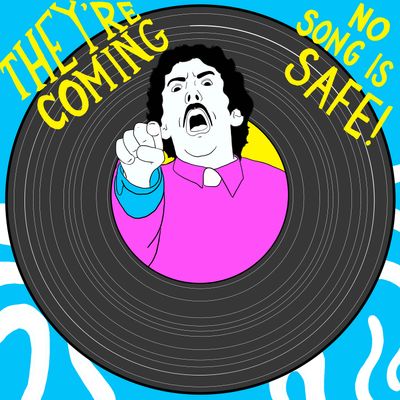
You’re right: A lot of pop music does sound the same. Literally! In the past five years, the number of new songs on Billboard’s year-end “Hot 100” chart that interpolate old songs has more than doubled. As the streaming money came to overshadow album-sales money, these sonic callbacks have become an increasingly popular way to make a hit song. Olivia Rodrigo, Beyoncé, Maroon 5, and Nicki Minaj — who had a recent No. 1 hit with her remake of Rick James’s “Super Freak” — have all recently published songs that incorporate interpolations.
Take OneRepublic’s “I Ain’t Worried.” Created for Top Gun: Maverick, the song leans into the same nostalgia that the film does. But instead of pointing to the ’80s, the band borrows from the aughties. The song starts with a casually whistled melody and a rudimentary drum groove reminiscent of the Peter Bjorn and John breakout song “Young Folks,” which itself launched a wave of nostalgic whistling (Edward Sharpe & the Magnetic Zeros’ “Home” and Foster the People’s “Pumped Up Kicks”). “I Ain’t Worried” isn’t a cover, and its whistling isn’t sampled. But as an interpolation, it’s a kind of reboot, incorporating musical ideas from another song by rerecording and/or reimagining them. In the process, OneRepublic pulled off a classic Hollywood move, making a top-20 hit out of a song that never reached “The Hot 100.”
Turning old songs into new hits is an age-old strategy; Elvis famously did it with “Hound Dog,” a cover of an interpolation of Big Mama Thornton’s original (as did Doja Cat recently). But listeners are wanting more of these familiar sounds, and the music industry is responding: Publishers have spent the past few years paying hundreds of millions of dollars for legacy-artist catalogues, and one way to wring more value out of those catalogues is to pitch interpolations. Merck Mercuriadis, founder of the publicly traded music-IP investment firm Hipgnosis Songs Fund, tells Switched on Pop that he’s always suggesting that songwriters, producers, and A&Rs use songs from his company’s portfolio — frequently with success. He says this strategy works because “classic songs are already part of the fabric of our lives.”
Another strategy is to serve up ready-made interpolations to major artists as preproduced tracks. Justin Shukat, president of the music publisher Primary Wave, told Switched on Pop that his company has hosted songwriting camps concentrated on leveraging interpolations in its catalogue; Primary Wave selected Semisonic’s classic hit “Closing Time” for a camp that pumped out “six or seven different versions of it.” Shukat sent one of those interpolations to Iann Dior, and Dior used it as the basis for his song “Thought It Was.”
With TikTok mashing up culture at increasing speeds, newer entrants are also trying their hand at this technique. The melody of Rita Ora and Imanbek’s “Bang Bang” is built on the main theme from Beverly Hills Cop. Yung Gravy Rickrolled the whole world with “Betty (Get Money),” which updates Rick Astley’s “Never Gonna Give You Up.” And Latto’s “Big Energy” is a double whammy, both sampling the Tom Tom Club’s “Genius of Love” and interpolating lyrics from Mariah Carey’s “Fantasy,” which was based around the same sample. It’s a trend that doesn’t seem to be slowing down: Mercuriadis says that “Nicki Minaj and Rick James being No. 1 has just sent 1,000 artists, producers, and songwriters searching for the next holy grail.”
*An earlier version of this post misidentified the iann dior song that interpolates Semisonic’s “Closing Time.”




